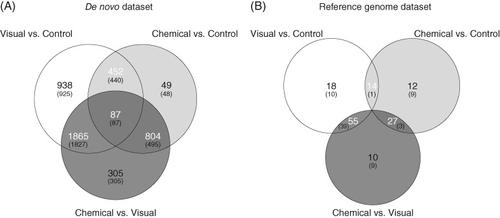当前位置:
X-MOL 学术
›
Genes Brain Behav.
›
论文详情
Our official English website, www.x-mol.net, welcomes your feedback! (Note: you will need to create a separate account there.)
Brain transcriptomic responses of Yarrow's spiny lizard, Sceloporus jarrovii, to conspecific visual or chemical signals
Genes, Brain and Behavior ( IF 2.5 ) Pub Date : 2021-05-25 , DOI: 10.1111/gbb.12753 Cristina Romero-Diaz 1 , Cindy Xu 1 , Stephanie M Campos 2 , Morgan A Herrmann 1 , Kenro Kusumi 1 , Diana K Hews 3 , Emília P Martins 1
Genes, Brain and Behavior ( IF 2.5 ) Pub Date : 2021-05-25 , DOI: 10.1111/gbb.12753 Cristina Romero-Diaz 1 , Cindy Xu 1 , Stephanie M Campos 2 , Morgan A Herrmann 1 , Kenro Kusumi 1 , Diana K Hews 3 , Emília P Martins 1
Affiliation

|
Species with multimodal communication integrate information from social cues in different modalities into behavioral responses that are mediated by changes in gene expression in the brain. Differences in patterns of gene expression between signal modalities may shed light on the neuromolecular mechanisms underlying multisensory processing. Here, we use RNA-Seq to analyze brain transcriptome responses to either chemical or visual social signals in a territorial lizard with multimodal communication. Using an intruder challenge paradigm, we exposed 18 wild-caught, adult, male Sceloporus jarrovii to either male conspecific scents (femoral gland secretions placed on a small pebble), the species-specific push-up display (a programmed robotic model), or a control (an unscented pebble). We conducted differential expression analysis with both a de novo S. jarrovii transcriptome assembly and the reference genome of a closely related species, Sceloporus undulatus. Despite some inter-individual variation, we found significant differences in gene expression in the brain across signal modalities and the control in both analyses. The most notable differences occurred between chemical and visual stimulus treatments, closely followed by visual stimulus versus the control. Altered expression profiles could explain documented aggression differences in the immediate behavioral response to conspecific signals from different sensory modalities. Shared differentially expressed genes between visually- or chemically-stimulated males are involved in neural activity and neurodevelopment and several other differentially expressed genes in stimulus-challenged males are involved in conserved signal-transduction pathways associated with the social stress response, aggression and the response to territory intruders across vertebrates.
中文翻译:

亚罗刺蜥(Sceloporus jarrovii)对同种视觉或化学信号的脑转录组学反应
具有多模式交流的物种将来自不同模式的社会线索的信息整合到由大脑中基因表达变化介导的行为反应中。信号模式之间基因表达模式的差异可能揭示多感官处理的神经分子机制。在这里,我们使用 RNA-Seq 分析大脑转录组对多模式通信的领地蜥蜴中化学或视觉社会信号的反应。使用入侵者挑战范式,我们暴露了 18 只野生捕获的成年雄性Sceloporus jarrovii男性同种气味(股腺分泌物放在小卵石上)、特定物种的俯卧撑展示(程序化的机器人模型)或对照(无气味的卵石)。我们使用 de novo S进行了差异表达分析。jarrovii转录组组装和密切相关物种Sceloporus undulatus的参考基因组. 尽管存在一些个体差异,但我们发现大脑中基因表达在信号模式和两种分析中的控制方面存在显着差异。最显着的差异发生在化学和视觉刺激治疗之间,紧随其后的是视觉刺激与对照。改变的表达谱可以解释记录在案的对来自不同感觉方式的同种信号的直接行为反应中的攻击性差异。视觉或化学刺激的男性之间共享的差异表达基因参与神经活动和神经发育,刺激挑战男性中的其他几个差异表达基因参与与社会应激反应相关的保守信号转导途径,
更新日期:2021-05-25
中文翻译:

亚罗刺蜥(Sceloporus jarrovii)对同种视觉或化学信号的脑转录组学反应
具有多模式交流的物种将来自不同模式的社会线索的信息整合到由大脑中基因表达变化介导的行为反应中。信号模式之间基因表达模式的差异可能揭示多感官处理的神经分子机制。在这里,我们使用 RNA-Seq 分析大脑转录组对多模式通信的领地蜥蜴中化学或视觉社会信号的反应。使用入侵者挑战范式,我们暴露了 18 只野生捕获的成年雄性Sceloporus jarrovii男性同种气味(股腺分泌物放在小卵石上)、特定物种的俯卧撑展示(程序化的机器人模型)或对照(无气味的卵石)。我们使用 de novo S进行了差异表达分析。jarrovii转录组组装和密切相关物种Sceloporus undulatus的参考基因组. 尽管存在一些个体差异,但我们发现大脑中基因表达在信号模式和两种分析中的控制方面存在显着差异。最显着的差异发生在化学和视觉刺激治疗之间,紧随其后的是视觉刺激与对照。改变的表达谱可以解释记录在案的对来自不同感觉方式的同种信号的直接行为反应中的攻击性差异。视觉或化学刺激的男性之间共享的差异表达基因参与神经活动和神经发育,刺激挑战男性中的其他几个差异表达基因参与与社会应激反应相关的保守信号转导途径,


























 京公网安备 11010802027423号
京公网安备 11010802027423号